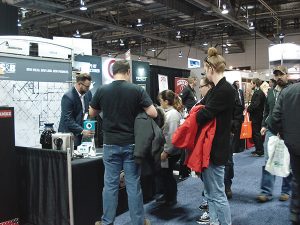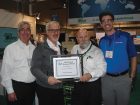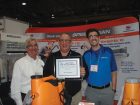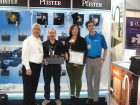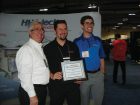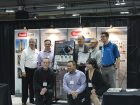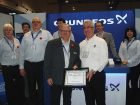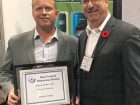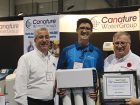
Delegates embrace learning opportunities at CIPHEX West
December 6, 2018 | By Kerry Turner and Jillian Morgan
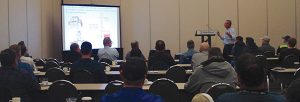
HPAC columnist John Siegenthaler was on hand to present two long-form sessions, one on modifying existing hydronic systems for lower water temperatures and another on documenting hydronic systems.
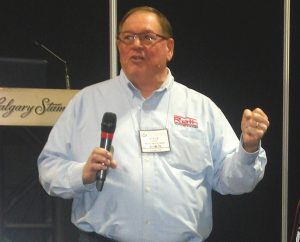
Steve Gibbs, product manager, trainer and radiant designer with Roth Industries, enlightens attendees on the benefits of wall and ceiling radiant.
By Kerry Turner and Jillian Morgan
CIPHEX West two-day trade show ran November 7 and 8 and drew almost 3,000 visitors who checked out more than 200 manufacturer’s offerings. In addition, delegates were able to sit in on seminars addressing such topics as radiant ceilings, the 2020 National Plumbing Code (NPC) and rainwater harvesting.
Though simple in concept, executing a rainwater harvesting system requires an in-depth understanding of system design and key components. According to Edward Van Giesen, national sales manager for Watts RainCycle, early planning and analysis are essential to avoid running up costs.
Giesen shared the fundamentals of commercial rainwater harvesting at CIPHEX and attracted a standing room only crowd.
The systems encompass everything from collection to end-use of rainwater, which Giesen noted refers to unused precipitation, not gray water, reused water, reclaimed water or recycled water.
Typically, the set up includes an inlet pre-filter, storage, filtration, disinfection and distribution. Rain carries atmospheric pollution as it falls, so pre-filtration is essential, Giesen said.
The presentation analyzed a slew of pre-filter types, including inlet pre-filter with internal airflow, sloped screen filter, basket filter, hydraulic jump style filter and cascade style filter, among others.
He noted that one particular style–a baffle-type box with zero invert difference–could lead to a “bacterial soup” and will require frequent cleaning.
Giesen capped the presentation with a rundown of the fundamentals: have proper ventilation, eliminate light, prevent animal access, allow for human access and consider equipment retrieval.
Rainwater harvesting is just one of the areas of change coming in the 2020 NPC, according to chief plumbing and gas administrator and inspector for the Government of Alberta, Sidney Manning. Among the other changes discussed by Manning at CIPHEX were water reuse, legionella, metrification, language, imported products, water reuse, and personal hygiene devices, to name a few.
A shift away from metrification, Manning said, will align with industry specifications, such as gauge and millimetre. Personal hygiene devices for water closets will also be included in the code.
The acceptance of imported European products into the Canadian market will grow by 500 labels this year, according to Manning. He added this offered a “huge opportunity” for wholesalers.
Water reuse will be the biggest change, though. The code will see the addition of non-potable rainwater harvesting systems, which includes a cistern, piping, fittings, pumps and other plumbing appurtenances required to collect and distribute rainwater.
A non-potable rainwater harvesting system excludes rain barrels not connected to the plumbing systems. It must also be provided with a means to treat the water so the quality of the delivered non-potable water meets provincial or territorial requirements.
For the system design, roof surfaces used for non-potable rainwater harvesting systems must be inaccessible to vehicles and pedestrians.
Manning shared a few of the devices that non-potable harvested rainwater can supply, including water closets and urinals, trap priming, irrigation, hydronic systems and cooling tower make up systems.
He said “a lot of work” was done in particular around the language used for public versus private and potable versus non-potable water.
The updated code will include clarification regarding connections of non-potable water to potable water and public versus private systems. It will also include clarification of exemptions and prohibition of locations for non-potable water piping. The code will also recognize unions for pumped sumps to “minimize conflict with prohibition of union joints.”
When it comes to variances, the code indicates that only a technical administrator can issue a variance in respect to: the pressure equipment discipline; a product, equipment, or distance measurement in the gas discipline; or a product, equipment or distance measurement in the plumbing discipline, according to Manning–and only a technical administrator may issue a province wide variance.
NEW PRODUCT COMPETITION WINNERS
Sixty new products were featured in the 2018 CIPHEX West New Product Competition with eight of those products being named winners. To be a finalist each product must have demonstrated innovation in terms of utilization for function, while offering a variety of benefits to the industry members who sell, install or specify the products and, ultimately, to the end-user.
New Product Competition winners, decided through a jury of industry experts, were presented with plaques by Ralph Suppa, CIPH president and general manager and show committee chair Austin Roth of Wolseley Canada.
- Sean Giberson and Rick Mayo of Taco Comfort Solutions accept the award for Taco’s Hot-LinkPlus-E in the Plumbing and Piping category.
- Mike Hardy accepts the award for Speedclean’s Dry Steam Coil and Surface Cleaner in the Tools and Equipment category.
- Sam Spataro and Karin Dusange accept the award for Pfister’s Deckard 2-Hole Roman Tub Filler, Spectrum Brands in the Kitchen and Bath category.
- Tim Prevost of Energy Saving Products, accepts the award for the ESP Series Variable Speed Heat Pump, Hi-Velocity in the Air Conditioning and Refrigeration category.
- The HeatLink team proudly displays the Controls and Instrumentation award for its Smart System. Photo courtesy CIPH
- Grundfos Canada president Simon Feddema accepts the award for the Grundfos MLE in the Heating and Ventilation category.
- Accepting for Flexcon is the agent Mike Stringer of Stringer Sales. Flexcon won for its Argosy Buffer Tank, Flexcon Industries in the Hydronic Heating category. Photo courtesy CIPH
- Dale Lewgood of Canature WaterGroup accepts the award for the Aqua Flo High Efficiency Reverse Osmosis (H.E.R.O.) in the Water Treatment category. Photo courtesy CIPH
CIPHEX West is produced for the industry by the Canadian Institute of Plumbing & Heating, with support from the Canadian Water Quality Association, the Mechanical Contractors Association of Canada, the Mechanical Contractors Association of Alberta, the Canadian Hydronics Council, the American Society of Plumbing Engineers and the Thermal Environmental Comfort Association.
CIPHEX West 2020 will be held in Vancouver on November 4 and 5 at the Pacific National Exhibition–Coliseum.

